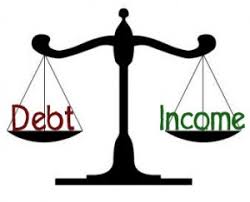Four Reasons Debt to Income Ratio is Important


![]() Your debt to income ratio is determined by taking all the payments you have during the month and dividing that by your gross monthly income. This is the number that lenders use to determine whether or not you can manage your monthly payments and can repay them.
Your debt to income ratio is determined by taking all the payments you have during the month and dividing that by your gross monthly income. This is the number that lenders use to determine whether or not you can manage your monthly payments and can repay them.
Your gross income is the amount of money that you make before taxes or other deductions are factored in. For example, let’s say that your mortgage is $1,500, your car loan is $100, and the rest of your expenses total $400. This means that your monthly debt payments equal $2,000. Now, let’s say that every month you make $6,000. Since $2,000 is 33 percent of $6,000, this means your debt to income ratio is calculated at 33 percent.
Some lenders will not lend money to individuals that have a debt to income ratio of 43 percent or more. People who have a debt to income ratio of more than 43 percent have trouble making their monthly payments.
Four Important Facts about Showing the Importance of Your Debt to Income Ratio
- The lower your debt to income ratio, the better balance exists between your debt and your income. The lower the percentage, the better the chance you will get a loan or a line of credit. A high debt to income ratio means that you have too much debt for the amount of income you earn. Lenders see this as a sign that you will not be able to repay financial obligations.
• Your debt to income ratio does not have a direct impact on your credit score. Credit agencies have no way of monitoring the amount of money that you earn. They look at the amount of debt you have and compare it to the amount of credit that you use to determine whether you would be a credit risk. For example, if your credit card balance is $4,000 and you have a credit card limit of $10,000, you have a debt to credit ratio of 40 percent. The more money that you owe relative to your credit limit, the lower your credit score will be.
• Front end debt to income ratio is different than back end debt to income ratio. Front end debt to income ratio just calculates housing expenses, such as mortgage, rent, property taxes, homeowners’ insurance, etc. Back end debt to income ratio calculates debt excludes housing expenses.
• Your debt to income ratio is based on your pretax income, so it may present an overly optimistic view of your finances. A person who makes $4,000 a month is on the 25 percent federal tax income bracket. This is without factoring in state and local taxes. This person would pay around $7,738 a year in federal income tax, or $644 each month. This means that the actual money they take home is around $3,355 each month. If their debt to income ratio was factored in this number, the outcome would be significantly different.
The Real-World Effects of Debt to Income Ratio
From a practical perspective, the lower your debt to income ratio is, the more financially secure you are. People who have a lower debt to income ratio are able to better handle financial upheaval and are in a better position to take financial risk.
For example, a person who has a low debt to income ratio may be able to change their career to something that they love doing that pays a little bit less. They will not need to worry as much about adjusting to a lower income.
Debt equals stress. The higher your DTI, the more you can start to feel like you are working just to pay creditors. It feels like life is not moving forward. No one wants that. Many have benefited from talking to a financial advisor to help them determine what the ideal debt to income ratio is for them.
The truth is, all of the financial preparedness in the world cannot always protect your pocketbook in the case of an emergency. Educate yourself on your financial options should you ever find short on savings with unexpected expenses to cover. If you need to apply for a line of credit to resolve a short-term financial hardship, you might be surprised to find that your debt to income ratio may not be a criteria for approval.
How to Maintain a Healthy Debt to Income Ratio
There are times when you are going to have a high debt to income ratio. For example, you may be aggressively paying off your debt. However, if you have a high debt to income ratio and you are only making minimum payments, then that’s a problem.
There are only two ways to lower your debt to income ratio. The first is to increase your income. This may mean working overtime, getting a salary increase, joining the gig economy, or generating money from a hobby. The more you can increase your income without increasing your debt payments, the lower your debt to income ratio will be.
The second is paying off your debt. This may cause a temporary increase in your debt to income ratio because you are spending more of your income paying down debt. However, once you pay off your debt, your debt to income ratio drops to zero because you are no longer spending your income on debt.
Most people will have some debt at different points in their life. The key is learning to control debt as opposed to letting debt control you.




